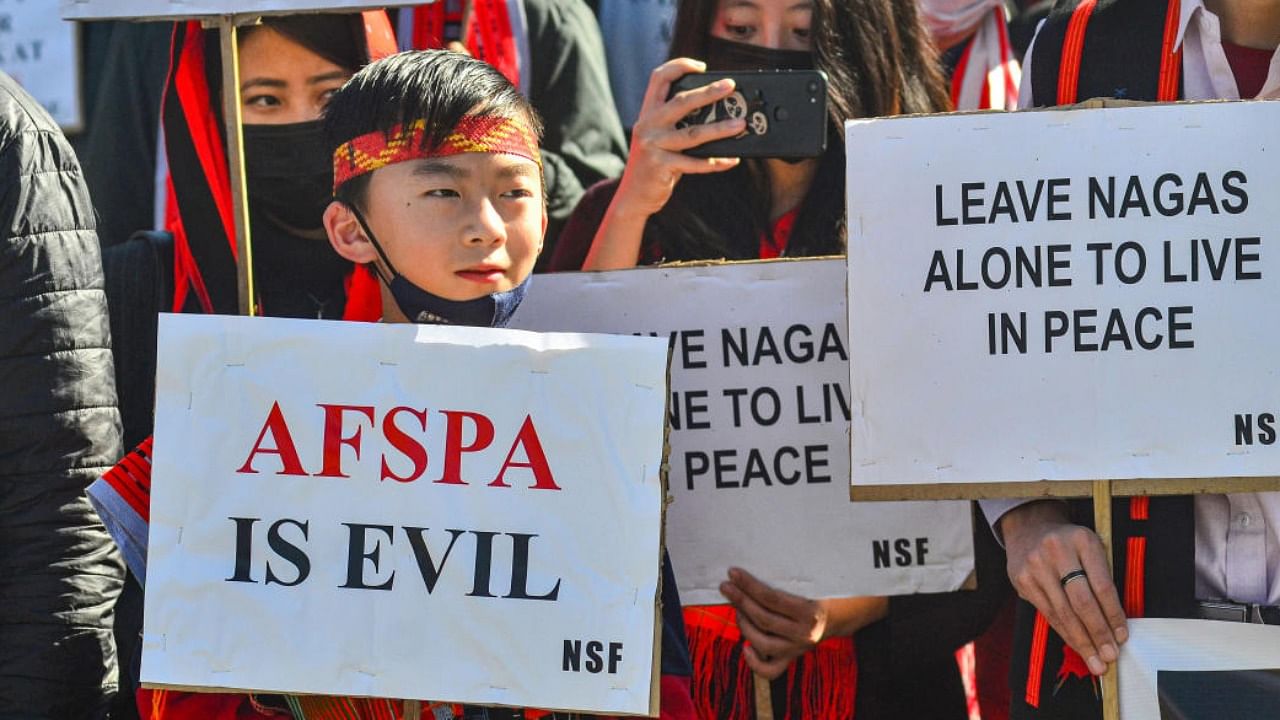
An impression has gained ground that perhaps the entire Naga population is against India, the Indian army, and other security forces. The state of Nagaland is now in poll mode. The recent killing of the Konyak Naga mineworkers has revived the demand for the repeal of the Armed Forces Special Powers Act (AFSPA). Elections are due in Nagaland in February 2023.
Chief Minister Neiphiu Rio, heading a coalition with the Bharatiya Janata Party (BJP) and another regional party, is under pressure and has backed the demand for the repeal of the AFSPA. Last week, he and his cabinet played the populist card and declared the formation of three new districts of Tseminyu, Chumuedima and Niuland. These are popular demands, and state minister Jacob Zhimomi described the announcement as the best Christmas gift.
However, December 4, 2021, indeed remains a black day, and the Naga population and, for that matter, other tribal communities in the northeast are against the AFSPA. The Naga people have faced enough brunt, so it is not without good reason that they oppose the AFSPA.
The Nagas or Khasis in Meghalaya could be anti-AFSPA. But it would be a big blunder of our time if in Delhi any ivory tower expert within the government apparatus or outside it labelled the entire Naga population and others as anti-India. Even to call them 'anti-Indian army' too would be erroneous. What is happening over the AFSPA is genuine, but the rest of it - taking the battle too far is part of politics.
The protests against the killings of Naga civilians could be part of a larger conspiracy to derail the peace talks between the Centre and Naga militant groups. The Naga National Political Groups, or NNPGs, an umbrella organisation of seven groups, still favour the early signing of the final Naga Peace Accord. So are a section of the Naga leaders.
"The Government of India and the central agencies will give the excuse that as long as the solution has not arrived, the AFSPA and the Disturbed Areas Act should be retained. As a Naga and as a politician working with various nationalist party leaders, I would like these black laws to go permanently from the Naga life. But to hope for this without the final solution may not help our struggle," former state minister N Thomas Lotha in The Nagaland Page, a local newspaper, recently wrote.
This journalist has spent many years with the Nagas and Mizos, and hence, I would not be wrong to suggest that for most Nagas and other communities in the region, there is a strong ethical and moral bond with the rest of the country. Hundreds of them are settled in Pune, New Delhi, Bengaluru and other Indian cities. People in the region have grievances against the army and the Centre, about which a former chief secretary of Nagaland, AM Gokhale, had once said, "New Delhi still thinks like Aurangzeb's Delhi."
But these simple tribal people, sometimes hot-headed, do not consider themselves out of tune with the Indian political system. If former prime minister Indira Gandhi was popular in Delhi and the cow belt states, she was popular in the northeast too. Naga and Mizo oldtimers still remember and hail her handling of the Bangladesh Independence struggle in 1971. If Narendra Modi is popular in the rest of India, people had received him with much enthusiasm when he visited Kohima in Naga attire.
To strengthen my argument, I will take the clock back to 1999 when Indian army jawans and officers laid down lives in the hills of Kargil. When Indian soldiers were fighting Pakistani intruders, the Nagas and Khasis had decided where they stood. The solidarity in the northeast with the Indian army is a proposition that many experts in Delhi and social media activists fail to appreciate.
The ultras had served warnings in many places asking locals to stay away from the Indian army's war efforts. Locals declined to oblige.
In the Kargil hills, among the martyred soldiers were Lieutenant Neikezhakuo (alias Neibu) Kengurusie, an Angami Naga from Nerhema village. He attained martyrdom on June 28, 1999, at Black Rock, Kargil, at the tender age of 24. The 2 Rajputana Rifles officer was later posthumously awarded the Maha Vir Chakra, India's second-highest gallantry award. His funeral journey from Dimapur airport to Kohima left hundreds with moist eyes, and the gathering was huge.
"Nagaland has not seen anything like that since the death of its legendary leader Phizo in 1989," reported The Indian Express. However, this even though the Naga rebels have collaborated with Pakistani ISI elements and go-betweens from time to time. The same sense of pride pervaded in Meghalaya as well. Captain K Clifford Nongrum sacrificed his life in the difficult Batalik sector.
There was a wave of criticism when the ULFA announced its support to the "Kashmiri freedom fighters" in their newsletter 'Freedom' during the Kargil conflict. "No Assamese in the remotest part of the state will help or support Pakistan," Assam Sahitya Sabha's Chandra Prasad Saikia had said then. In Assam's Sibsagar district, one ULFA activist was killed when he stopped locals from raising funds for the army during the Kargil conflict.
In the final analysis, here is what Nagaland's only Christian governor, MM Thomas, who was from Kerala, as reported in Kohima's Weekly Journal on February 27, 1991, said: "You don't give a second thought to writing against the state (government) fully aware that the state will not retaliate to the extent these anti-national elements would."
(The author is a journalist and author based in New Delhi)
Disclaimer: The views expressed above are the author's own. They do not necessarily reflect the views of DH.
Check out DH's latest videos: